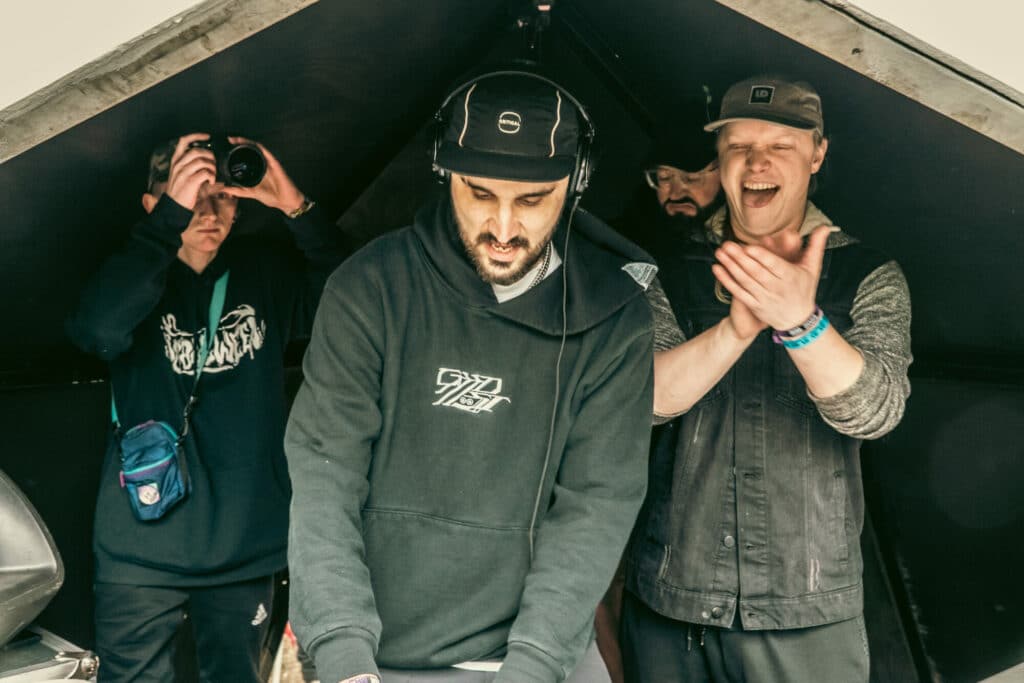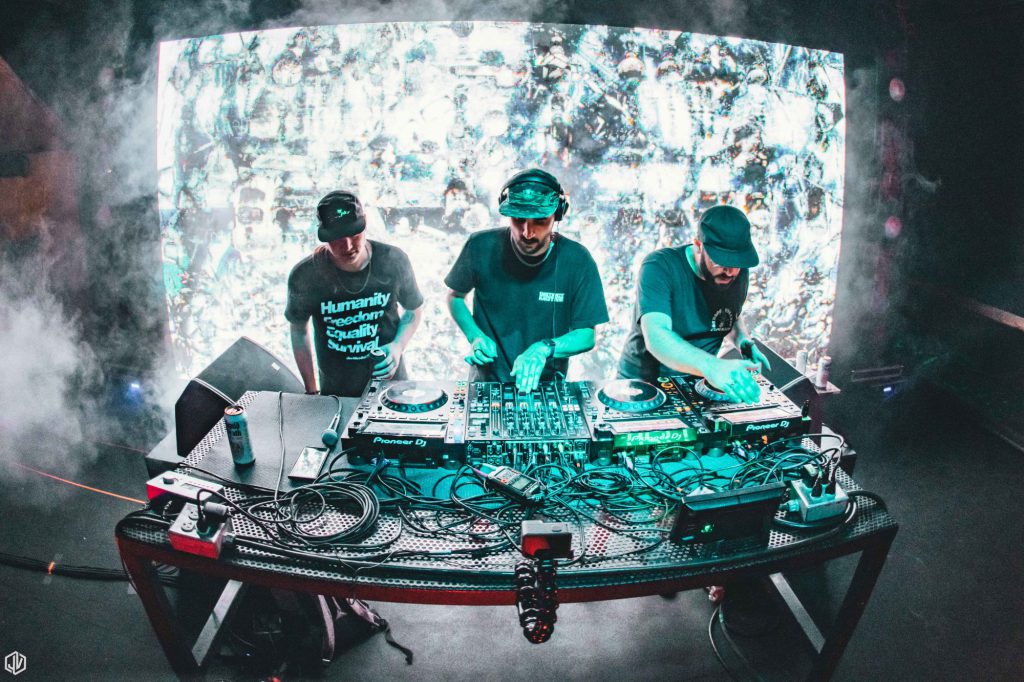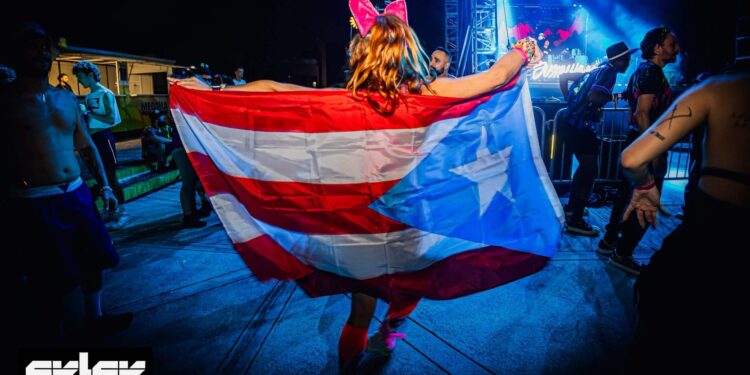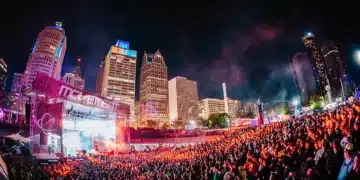Ternion Sound digs into their new album, their teamwork-focused mindset, and the roadblocks they face in the ever-changing music industry.
Ternion: the number three; three things together; a ternary or triplet. Three proved to be a lucky number when Andrew Hill, Jack Denney, and Aric Okerman joined forces as Ternion Sound in 2016. During their solo ventures as local DJs in Minneapolis, the trio spontaneously came together to play at their home festival at Infrasound. Their live energy and artistic visions were immediate and obvious matches with one another, and Ternion Sound was born.
With a deep love for sound system culture, old-school rave culture, and the underground, the rise of Ternion Sound has been a snowballing force in bass music in recent years. It’s easy to understand why after you witness them cook up risky doubles, play tunes the crowd has never heard, and even surprise each other on stage with new edits. They may be well-known in the 140 dubstep realm, but you’ll never hear just one tempo or style of bass music in a Ternion Sound set. Or, in this case, on a Ternion Sound album.
With a slew of releases behind them on countless notable bass imprints from Deep, Dark & Dangerous to Infernal Sounds, fans have heard whispers of the trio’s debut full-length album for years. The first single from Digital Artifice hit streaming sites last month, showcasing some more emotional sonics from Ternion Sound than a casual listener may have expected. It was also revealed that the project had found its home on NOSIA‘s coveted label Vision Recordings and would feature a whopping 26 tracks.
Ternion Sound stated that the label head had been a massive inspiration to the trio from the start of their careers, and there was clearly no better home for Digital Artifice. A true embodiment of their celebrated sound, the project explores a myriad of BPMs and sounds that sequentially flow to create its dystopian story. We got to dig a bit deeper into the tale with Jack from Ternion Sound, as well as the challenges they encounter within the scene and a lot more.
Digital Artifice is out everywhere now, so be sure to head to Spotify or your preferred platform to hear all 26 tracks for yourself and keep reading for the exclusive interview.
Stream Ternion Sound – Digital Artifice on Spotify:
Hi Jack, thanks for taking the time to chat with us about the new album! We know it was years in the making, so can you start off by giving fans a bit of insight into the creative process behind a project this large? How did tracks move from living in Ternion Sound’s collection of WIPs/IDs to finding their homes on Digital Artifice?
It happened almost just as you explained it: we set a folder aside for the last few years of WIPs we thought would work for the album, and as that folder grew, it started to take shape. We had a lot of different concepts we wanted to try out, so there were a lot of things that didn’t end up fitting; probably 100+ WIPs cycled through the album working folder before we ended up with these 26. We knew we wanted stuff that would encapsulate the kind of “active dancefloor” material we like to play live but also was good for listening at home and in headphones.
Another major factor was that we wanted it presented as a DJ mix, which, to us, is the way that most electronic music is intended to be consumed. Many tracks have intros and arrangements that are structured for ease of DJing and can be boring to listen to stand-alone. We wanted to present the album the way you’d maybe hear it live in its intended space.
Tracks like “Looking Up,” “Artifice,” and “Vapor” offer different emotions and tempos than listeners may have expected from Ternion Sound while still remaining true to your style. Can you speak a bit on the emotional side and storytelling aspect of the album and how you intended for it to be received as a whole unit?
Part of making this album a good listening experience overall was including tracks like this. I would say Ternion has always released more introspective and less “banger” dancefloor tracks like these, but they aren’t our most popular. Looking back to older releases, stuff like “The Chamber,” “Nicky P,” “Morgawr,” “Know Thyself,” etc, I think we are more known for major dancefloor tunes because they get played heavily by other DJs. The “B-sides” have always contained these tracks, and we really wanted to make the statement with the album that we’re not interested in only writing bangers. Sometimes, as we grow in popularity, it feels like there’s an expectation to only play heavier and heavier stuff, so this kind of presses against that.
But as far as writing the tracks themselves goes, I think we always want to focus on themes related to how it feels to live in the time we’re living in. The anxieties and fears over stuff like climate change and rising ultranationalist ideologies across the globe, the feeling of being stuck and powerless to do anything about it, the depression of being broke and living in a shitty economy. This is the kind of stuff we’re thinking about a lot of the time when writing. I think by sharing these experiences instead of avoiding them and seeking escapism, we have a better chance of finding solutions.

While you’ve discussed your divided creative load with the Ternion Sound project as a trio plenty before, what did working as a group over months and years look like on this album? In what ways did you surprise each other?
It hasn’t looked much different than our usual workflow, but the major changes are that we stopped sharing a physical studio space during 2020, and Andrew now lives in another state, so a lot more communication happens online. There are a lot of 10-20 minute voice message rants from me in the group chat (imagine my Instagram stories, but worse), and we discuss a lot about philosophy and direction and intention for what we’re doing.
One other major thing is that since 2021 and touring opened again, Aric and I have spent much more time on the road. 80+ shows a year means we are gone most weekends and chunks of the week too, which means less studio time. Fortunately, Andrew is the most comfortable in the studio, so he’s become even more of “the finisher” with tracks and does the bulk of the writing.
Prior to 2020, we were only sending 1 member to most gigs, sometimes 2, and we only had 30 shows a year, so we all had a lot more time. With rising flight costs, this might become a reality again, though. We’re going to start dividing up more of the gigs so that we can have more time in the studio because the division of labor has been disrupted somewhat. We can’t really tour less because it’s nearly 100% of our income. We need to keep the machine running to keep the music flowing, but we need to cut expenses and free up time to keep up with the demands of work and the increasing cost of living.
It’s a rough situation for sure and affects how much we can write and the quality of the music as well. All in all, the biggest surprise over the course of the album is mostly that we got it done and didn’t divert into other plans and release a string of EPs.
What other challenges are you continually facing in the industry, and how do you work around them?
The biggest issues we face regularly have to do with the structure of the music industry and the general form it’s taken in recent years, in the US particularly. We need to tour constantly in order to do it all full-time, but touring constantly means playing a lot of less-than-ideal shows in less-than-ideal venues. A lot of electronic music is starting to shift into and operate in venue spaces designed for concerts, bands, etc. These spaces aren’t conducive to the kind of dancefloor experience we want to create for a number of reasons.
Bad sound, mismatched aesthetics, and even stuff like lineups being headliner-focused (run of the show being headliner, direct support, local opener, local opener, etc) aren’t really in the direction we want to go. Rave music, to us, was always an alternative to that kind of structure. You went to a party for a full experience, not just to see one act and sit around waiting during the opening acts. It all feels much more like a rock concert now. Even the dancefloor energy is diminishing; there’s much less activity and movement, and this is something commonly blamed on dissociative use, but I think the issue is much more cultural.
I’m not sure if it’s because so many industry folks now have training and education in the traditional music business or because so much of the industry is operated within LiveNation venues, facilitated and managed by groups like AEG, Wasserman, and UTA. All of those, in my eyes, are from the “old world” corporate structure, which ultimately is designed to funnel money into a shrinking group of top-performing artists and monopoly business ventures like LiveNation. Yet something is definitely amiss in the way things are done lately. It’s absolutely the biggest issue for us regularly, though. Trying to get shows to work more for us has a lot of roadblocks.

Looking back on the rise of Ternion Sound, you’ve never relied on marketing gimmicks or get-big-quick strategies. Instead, you’ve consistently evolved while staying true to yourselves. Can you share what that experience has been like while growing in the scene? Is there any advice you can offer others who might struggle with this?
It has been difficult in a lot of ways, but also not as difficult as you might expect. What it really means at the end of the day is just staying vigilant with where we play, who we play for, what kind of offers we’re getting, discussing pay structuring and facilitating transparency with other artists, and generally having a mindset that’s business-skeptical but not business-aloof. You can’t just forget about that side of things because you’ll either get fucked by the bad guy or you’ll turn into the bad guy.
We’ve had offers to be a part of bigger things that we’ve turned down because it’s not a great fit for our long-term plans, but we also have to compromise sometimes. We try to do that in places where it makes sense. There’s a tension between trying to grow our platform and secure more ability to create a scene that works for everyone and trying to keep the “industry” at arm’s length. We do a lot of smiling and nodding [Laughs].
Fortunately, there are decent people out there wherever you look, and it’s not all bad if you build connections with the right people. This is my biggest advice. You can’t do anything alone, no man is an island. You’ve got to find good people and work together with them on shared goals. Social alienation is the antithesis of liberation.
Your deep-rooted love for the culture not only helped lead to your success but has been a catalyst for your dedication to keeping it alive. You have been known to speak out about various difficult topics, from dance floor etiquette to drug culture to fair wages in the industry, so what is your take on the current state of the US dubstep scene and culture?
It’s both in its best state and most frustrating state simultaneously. In many ways, things are great: a lot of people are having success and making enough money to seek out careers, ticket sales are strong, and there’s a lot of interest in “underground” stuff outside of the whole EDM/festival thing. A lot of incredible music is coming out too; people are experimenting, music technology and tools are more advanced than ever, and we have access to so many more sounds.
On the other hand, I think the same old problems are around. Growing audiences means growing pressures on what kind of music to play and make. A lot of people are focusing too heavily on making bangers and stuff that gets a crowd reaction. This is taking the whole “deep” dubstep (I hate that term, but whatever), thing and turning it almost into another era of tear-out or “brostep.”
A lot of great ideas are getting passed over because of the rabid focus on being blown away by every piece of music. I think more subtlety and nuance could be a good thing for both fans and producers alike to develop. I also think that dubstep in the US is integrated with many other forms of bass music and EDM that have an impact on its sound, which can oftentimes leave us in a weird place.
We get put on many lineups where we don’t fit because the kids are looking for something else. And there’s nothing wrong with that! The other stuff is great too. I’m even a big fan of glitchy/halftime/neuro stuff and even a lot of the psychedelic downtempo stuff, you know, but it’s just such a different aesthetic to ours. When the tent is too big, it kind of forces compromise on everyone’s visions. We should all be given more space to cultivate full experiences the way we see fit.
Finally, as the mainstream side of the scene has grown, rave culture and its roots have been continually washed away. How can fans and aspiring producers do their part to keep it alive and well so that the legacy of the rave can continue?
For me, the biggest thing here is just taking the time to go back in history. We’re so focused on today’s music, and I think there’s such a risk of 30-40 years of rave music history just being lost to the sands of time. So many of the issues we have now culturally have existed and been solved in the past. And so many great ideas, both in terms of club culture and in terms of sound, have been passed over and lost to time. I spend a lot of time digging through old rave music archives, trying to soak up the sound and inspiration, and it helps me contextualize what we’re doing in a historical continuum.
It feels like most of what we do today is devoid of that historical context. Dubstep, especially in the US, grew almost entirely in the absence of the greater rave scene and history associated with it. I think without historical context, you end up with these crisis-of-meaning moments that afflict so much of the discourse. There’s no common shared value or ethos to provide direction, and I think we could use that. Be that with ideas like inclusivity, providing an alternate power structure to the monopoly-dominated music industry, having a strong DIY ethos that’s community-focused from the bottom-up, eschewing headliners and celebrity worship, etc.
Follow Ternion Sound:
Facebook | Twitter | Instagram | SoundCloud | YouTube | Twitch








